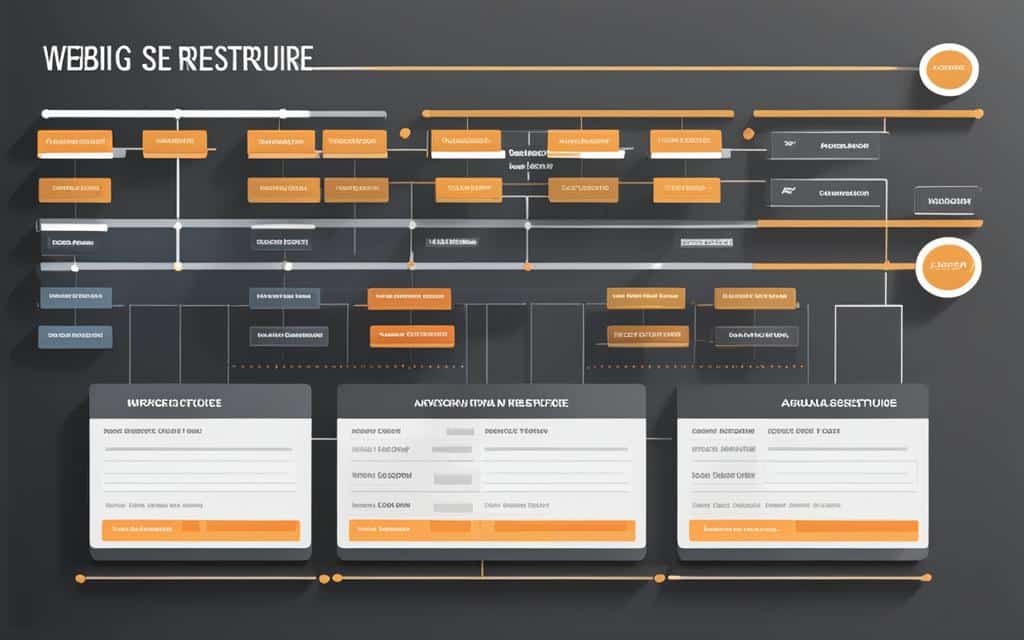Table of Contents
When it comes to site architecture, building an SEO-friendly structure is key. Site architecture refers to how a website’s pages are structured and linked together, and it plays a crucial role in SEO. An optimized site architecture not only helps search engine spiders find and index all the pages on your site, but it also improves user experience and makes it easier for visitors to find what they need.
So, how do you go about building an SEO-friendly site architecture? The first step is to use a flat architecture. This means organizing your pages in a way that allows users to reach any page on your site in just a few clicks. By keeping things simple and using category pages, you can ensure that both search engines and users can easily navigate your site.
Optimizing your URL structure is another important aspect of building an SEO-friendly site architecture. Make sure your URLs are descriptive and contain relevant keywords. This not only helps search engines understand what your pages are about, but it also makes it easier for users to remember and share your URLs.
Strategic internal linking is also vital for an SEO-friendly site architecture. By linking related pages together, you can guide search engines and users through your site, and distribute link authority throughout your website.
Finally, don’t forget to utilize a sitemap. A sitemap is a file that lists all the pages on your site, making it easier for search engines to discover and crawl your site’s content.
By following these best practices for building an SEO-friendly site architecture, you can improve your site’s visibility in search engine rankings and provide a better user experience for your visitors.
What Is Website Architecture?
Website architecture refers to the arrangement and interconnection of a website’s pages. It plays a crucial role in SEO by helping search engine spiders find and index all the pages on a website. But it’s not just about SEO; a well-structured website architecture is also essential for providing a good user experience and ensuring that search engines understand the purpose of each webpage.
When planning website architecture, it is best to use a flat structure where users can reach any page on the site in 4 clicks or less. This allows for efficient link authority flow and maximizes crawl budget. By organizing content into categories and using logical URL structures, users can easily navigate through the website and find what they are looking for.
“Effective website architecture is like a well-designed road map that guides both users and search engines through the content of a website.”
Using category pages is another important aspect of website architecture. Category pages help group similar content together, making it easier for users to find related information. These pages also act as hubs that distribute link equity throughout the website, boosting the rankings of important pages.
Overall, a well-optimized website architecture ensures that search engines can crawl and index a website effectively, leading to higher rankings. At the same time, it enhances the user experience by providing a clear and logical structure that allows visitors to navigate the site easily.
To illustrate the importance of website architecture, take a look at the visual representation below:
| Website Architecture Features | Benefits |
|---|---|
| Flat structure | Efficient link authority flow and maximum crawl budget utilization |
| Logical URL structure | Enhanced user experience and easier understanding of webpage purpose |
| Category pages | Grouping related content and boosting rankings of important pages |
Why Is Website Architecture Important for SEO?
Website architecture plays a crucial role in SEO, and its importance cannot be overstated. An optimized website architecture not only improves the crawlability and indexability of a site but also contributes to higher search engine rankings and organic performance. Let’s explore the key reasons why website architecture is vital for SEO.
Improved Crawlability and Indexability
An optimized website architecture ensures that search engine spiders can efficiently crawl and index all the pages on a site. When search engines can easily discover and understand the content, it increases the likelihood of better rankings and visibility in search results.
Distribution of Link Equity
Link equity refers to the authority passed through links from one page to another. An optimized website architecture helps distribute link equity throughout the website, ensuring that important pages receive the necessary boost in rankings. By establishing a logical hierarchy and internal linking structure, you can maximize the impact of link equity on your most valuable pages.
Establishment of Topical Authority
A well-structured website architecture groups related content together, establishing topical authority in specific areas. By organizing your website’s pages into categories and subcategories, you create a cohesive and comprehensive user experience. This helps search engines understand the themes and topics covered on your site, further improving your rankings in relevant searches.
Enhanced User Experience
Website architecture directly impacts user experience by making it easier for visitors to navigate and find the information they need. A well-organized site structure with intuitive navigation ensures that users can quickly locate relevant content, enhancing their overall satisfaction. An improved user experience leads to increased engagement, longer dwell times, and higher conversion rates.
“Website architecture is the backbone of an effective SEO strategy. It serves as the foundation upon which search engines can efficiently crawl and index your site, while also providing a seamless user experience.”
To summarize, a well-optimized website architecture is crucial for SEO success. It improves crawlability and indexability, distributes link equity effectively, establishes topical authority, and creates a better user experience. By prioritizing website architecture in your SEO efforts, you can lay a strong foundation for higher rankings and increased organic performance.
Models of Website Architecture for SEO
When it comes to website architecture models for SEO, there are two main options: deep structure and shallow structure. A deep structure means that users need to click through multiple links to reach the desired page, while a shallow structure allows users to reach any page in just a few clicks.
A shallow structure is preferable for SEO as it minimises the steps required for search engines and users to find specific content. With a deep structure, link equity flow and crawling efficiency may be compromised. Therefore, it is essential to design a site architecture that prioritises a shallow structure for better SEO performance.
Implementing a shallow structure enables search engine spiders to easily navigate and index a website’s pages, making them more discoverable. It also enhances user experience by reducing the number of clicks needed to access desired information. A shallow structure helps search engines understand the hierarchy and importance of pages, improving their rankings in search results.
“An optimized website architecture with a shallow structure ensures efficient link equity flow and enhances crawlability and indexability.”
To illustrate the difference between deep and shallow structures, consider the following example:
| Deep Structure | Shallow Structure |
|---|---|
|
|
As shown in the example, the deep structure requires more clicks to access specific pages within subcategories, resulting in a higher number of steps for users and search engines. In contrast, the shallow structure allows direct access to any page within a category, reducing the navigation complexity.
By prioritising a shallow structure for website architecture models, businesses can improve SEO performance by simplifying user journeys, enhancing crawlability, and ensuring efficient link equity flow.
Best Practices for SEO Website Architecture
Implementing best practices for SEO website architecture can greatly enhance the structure and performance of a website. By following these guidelines, you can optimize your site architecture and improve its visibility in search engine results.
Map Out Taxonomy
Begin by mapping out the taxonomy of your website. Clearly define the categories and subcategories that organize your content. This ensures that your website is well-structured and easy for both users and search engines to navigate.
Create an intuitive navigation menu that allows users to easily find the information they need. A logical and user-friendly navigation system not only improves the overall user experience but also helps search engines understand the hierarchy and relationships between your webpages.
Simple URL Structure
Maintain a simple and organized URL structure that reflects the hierarchy of your website’s categories. This helps both users and search engines understand the context and relevance of your webpages.
Embrace Internal Links
Strategically incorporate internal links throughout your website to guide users and search engines to relevant content. Internal links not only improve navigation but also help search engines understand the relationships and importance of different pages within your website.
By adhering to these best practices, you can create a well-optimized and user-friendly website architecture that improves your SEO performance and enhances the overall user experience.
Implementing these best practices for SEO website architecture can greatly enhance the structure and performance of a website. By mapping out taxonomy, embracing intuitive navigation, maintaining a simple URL structure, and strategically incorporating internal links, you can optimize your site architecture for improved SEO performance.
Create an Optimal, SEO-Friendly Hierarchical Structure
To create an optimal, SEO-friendly hierarchical structure, it is important to consider the overall site architecture and its impact on user experience and SEO. A well-structured website not only improves search engine rankings but also enhances user satisfaction. Follow these guidelines to create a hierarchical structure that is both optimal and SEO-friendly:
- Use a flat structure: Implementing a flat structure allows users to reach any page on your website in just a few clicks. Avoid unnecessary layers of navigation that can lead to confusion and poor user experience.
- Organize clear categories and subcategories: Categorize your content into logical groups and subgroups. This helps search engines and users find and navigate through your website efficiently.
- Highlight important pages: Identify the most important pages on your website and ensure they are easily accessible. This can be done by featuring them prominently in your navigation menu or linking to them from multiple other pages.
- Optimize URL structure: Create a URL structure that reflects the hierarchy of your website’s categories. Use descriptive and meaningful URLs that are human-readable and search engine-friendly.
- Strategic internal linking: Use internal links to guide users and search engines to important pages within your website. Incorporate relevant anchor text and ensure that every page is reachable through at least one internal link.
By following these guidelines, you can create an SEO-friendly hierarchical structure that improves both search engine rankings and user experience.
Creating an optimal, SEO-friendly hierarchical structure is crucial for the success of your website. It not only helps search engines understand and index your content effectively but also enhances user satisfaction. Implementing a well-structured and user-friendly hierarchy will result in improved organic visibility and increased traffic to your website.
Conclusion
Building an SEO-friendly site architecture is crucial for improving rankings and enhancing user experience. A well-optimized site architecture helps search engine spiders find and index all pages, distributes link equity effectively, establishes topical authority, and creates a better overall user experience.
By following best practices such as using a flat structure, keeping things simple, utilizing category pages, optimizing URL structure, embracing internal links, and using a sitemap, a website can achieve an optimal, SEO-friendly site architecture. These best practices ensure that search engines can easily crawl and understand the website’s content, while also providing a smooth navigation experience for users.
In summary, site architecture SEO plays a vital role in organic performance. Implementing an SEO-friendly site architecture not only improves search engine rankings but also enhances user experience by making information easily accessible. By utilizing best practices and optimizing the site’s structure, webmasters can create a website that is both search engine friendly and user-friendly, resulting in increased organic traffic and improved online visibility.
FAQ
What is website architecture?
Website architecture refers to how a website’s pages are arranged and interconnected.
Why is website architecture important for SEO?
Website architecture is important for SEO because it helps search engine spiders find and index all the pages on a website, improves crawlability and indexability, distributes link equity, and enhances user experience.
What are the models of website architecture for SEO?
There are two main models of website architecture for SEO: deep structure and shallow structure. A deep structure requires users to click through multiple links to reach the desired page, while a shallow structure allows users to reach any page in just a few clicks.
What are the best practices for SEO website architecture?
The best practices for SEO website architecture include mapping out the website taxonomy, creating an intuitive navigation menu, maintaining a simple URL structure, utilizing internal links strategically, and using a sitemap.
How can I create an optimal, SEO-friendly hierarchical structure?
To create an optimal, SEO-friendly hierarchical structure, you should use a flat structure with clear categories and subcategories, prioritize a logical and intuitive hierarchy, optimize the URL structure, and strategically use internal linking.
Why is building an SEO-friendly site architecture important?
Building an SEO-friendly site architecture is important for improving rankings, enhancing user experience, and achieving better organic performance. It helps search engine spiders find and index all pages, distributes link equity effectively, establishes topical authority, and creates a better overall user experience.













